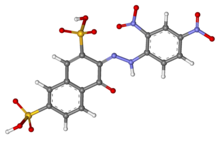Nitrazine
Appearance

| |

| |
| Names | |
|---|---|
| IUPAC name
(3E)-3-[(2,4-Dinitrophenyl)hydrazono]-4-oxonaphthalene-2,7-disulfonic acid
| |
| Other names
Nitrazine yellow; Phenaphthazine
| |
| Identifiers | |
3D model (JSmol)
|
|
| ChemSpider | |
PubChemCID
|
|
| UNII |
|
| |
| |
| Properties | |
| C16H10N4O11S2 | |
| Molar mass | 498.40 g/mol |
Except where otherwise noted, data are given for materials in theirstandard state(at 25 °C [77 °F], 100 kPa).
| |
Nitrazineorphenaphthazineis apH indicatordye often used inmedicine.More sensitive thanlitmus,nitrazine indicates pH in the range of 4.5 to 7.5. Nitrazine is usually used as the disodium salt.
Use
[edit]| Nitrazine(pH indicator) | ||
| below pH 4.5 | above pH 7.5 | |
| 4.5 | ⇌ | 7.5 |
- This test is done to ascertain the nature of fluid in the vagina during pregnancy especially when premature rupture of membranes (PROM) is suspect. This test involves putting a drop of fluid obtained from the vagina onto paper strips containing nitrazine dye. The strips change color depending on the pH of the fluid. The strips will turn blue if the pH is greater than 6.0. A blue strip means it's more likely the membranes have ruptured.
This test, however, can produce false positives. If blood gets in the sample or if there is an infection present, the pH of the vaginal fluid may be higher than normal. Semen also has a higher pH, so recent vaginal intercourse can produce a false reading.
- To perform afecal pH testfor diagnosing intestinal infections or other digestive problems[1]
- Incivil engineering,to determine thecarbonatationspread inconcretestructures and therefore assess the state of therebar'spassivationfilm.
References
[edit]- ^"Point-of-Care Testing, Fecal pH Measurement".Archived fromthe originalon 2007-07-03.
